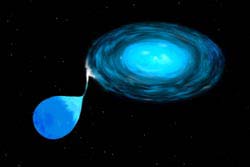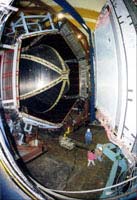This area deals with the fundamental laws and building blocks of nature and how they interact, the properties and the behavior of matter, and research into space and time and their structures.
innovations-report provides in-depth reports and articles on subjects such as astrophysics, laser technologies, nuclear, quantum, particle and solid-state physics, nanotechnologies, planetary research and findings (Mars, Venus) and developments related to the Hubble Telescope.

Using XMM-Newton, astronomers have obtained the world’s deepest ‘wide screen’ X-ray image of the cosmos to date. Their observations show newly discovered clusters of galaxies and provide insights into the structure of the distant Universe…
Unlike grains of sand on a beach, matter is not uniformly spread throughout the Universe. Instead, it is concentrated into galaxies like our own which themselves congregate into clusters. These clusters are ‘strung’ throughout the Universe in a web-like st

Argonne physicists have precisely measured the masses of nuclear isotopes that exist for only fractions of a second or can only be produced in such tiny amounts as to be almost nonexistent in the laboratory. Some isotopes had their masses accurately measured for the first time.
The results help explain the characteristic X-ray spectrum and luminosities of strange astronomical objects called “X-ray bursters.”
X-ray bursters comprise a normal star and a neutron star. Neutron stars

Physics Lab in Japan reports evidence for the Pentaquark; Jefferson Lab data supports discovery
A Five-quark state has been discovered, first reported by a group of physicists working at the SPring-8 physics lab in Japan. All confirmed particles known previously have been either combinations of three quarks (baryons, such as protons or neutrons) or two quarks (mesons such as pions or kaons). Although not forbidden by the standard model of particle physics, other configurations of qua

An international research team co-led by Prof. Harvey Richer of the University of British Columbia today announced that it has confirmed the existence of the universe’s oldest known and farthest planet.
The findings end a decade of speculation and debate as to the true nature of this ancient world, which takes a century to complete each orbit. The un-named planet is 2.5 times the mass of our solar system’s largest planet, Jupiter. Its existence provides evidence that the universe&

A method that can be used to predict the growth of earthquake faults also aids prediction of the tiniest of phenomena–how arrays of “artificial atoms,” or quantum dots, assemble and stack themselves on semiconductor materials, National Institute of Standards and Technology (NIST) researchers report in the July 15 issue of Physical Review B.
The insight could aid development of more reliable methods for fabricating lasers, sensors and other devices that exploit quantum dots’ special el

Magnetic memory-based information storage systems are getting smaller and smaller, while their capacities are getting larger. However, there is a limit to how small they can get. If the tiny magnets used to store information are smaller than around five nanometres (millionths of a millimetre), vibrations caused by temperature can erase their orientation and, therefore, the information they contain. This is known as the superparamagnetic limit, which physically limits the capacity of magnetic storage